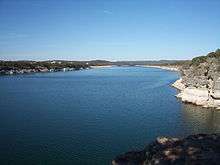Balcones Canyonlands National Wildlife Refuge
| Balcones Canyonlands | |
| National Wildlife Refuge | |
 Balcones Canyonlands National Wildlife Refuge | |
| Country | |
|---|---|
| State | |
| Region | Texas Hill Country |
| Nearest major city | Austin, Texas |
| Nearest river | Colorado River (Texas) |
| Coordinates | 30°37′21″N 98°04′06″W / 30.62250°N 98.06833°WCoordinates: 30°37′21″N 98°04′06″W / 30.62250°N 98.06833°W |
| Highest point | |
| - elevation | 750 m (2,461 ft) |
| Lowest point | |
| - elevation | 300 m (984 ft) |
| Area | 186 km2 (72 sq mi) |
| Founded | 1992 |
| Management | United States Fish and Wildlife Service |
 Map of refuge
| |
| Website: Balcones Canyonlands National Wildlife Refuge | |
Balcones Canyonlands is a national wildlife refuge located in the Texas Hill Country to the northwest of Austin.[1] The refuge was formed in 1992 to conserve habitat for two endangered songbirds including the golden-cheeked warbler and the black-capped vireo and to preserve Texas Hill Country habitat for numerous other wildlife species.[2] The refuge augments a similarly named preserve in Austin called the Balcones Canyonlands Preserve.
The refuge is located within a deeply dissected portion of the Edwards Plateau that contains many steep-banked streams and canyons.[3] The canyons facing Austin are deeply etched into the limestone of the Edwards Plateau by tributaries of the Colorado River.
Beneath the surface of the Edwards Plateau lies an underground labyrinth of caves, sinkholes and springs. Various spiders, beetles, and other creatures inhabit this below-ground world and are unique to this area of Texas. Even deeper below the surface lies the Edwards Aquifer, which stores billions of gallons of water and supplies drinking water for almost one million people. The aquifer is also the source of many springs that feed Hill Country rivers, which eventually flow into the marshes, estuaries, and bays along the Texas coast.[3]
The vegetation found in the Hill Country includes various oaks, elms, and Ashe juniper trees (often referred to as "cedar" in Texas). The endangered golden-cheeked warbler and black-capped vireo depend on different successional stages of this vegetation. Both of these birds nest in the Edwards Plateau, the warbler exclusively.[4]
See also
References
- ↑ United States Fish and Wildlife Service. "Overview". Balcones Canyonlands National Wildlife Refuge. Retrieved 2010-03-21.
- ↑ U.S. Senate, Committee on Appropriations. 2006. Prepared statement of Friends of Balcones Canyonlands National Wildlife Refuge. Senate Hearings, Department of the Interior and Related Agencies Appropriations, HR 2361, pp. 174-175.
- 1 2 United States Fish and Wildlife Service. "Wildlife & Habitat". Balcones Canyonlands National Wildlife Refuge. Retrieved 2010-03-20.
- ↑ United States Fish and Wildlife Service. "Visit". Balcones Canyonlands National Wildlife Refuge. Retrieved 2010-03-20.
External links
- USFWS.gov: Official Balcones Canyonlands National Wildlife Refuge website
- USFWS.gov: Profile of Balcones Canyonlands National Wildlife Refuge
![]() This article incorporates public domain material from websites or documents of the United States Fish and Wildlife Service.
This article incorporates public domain material from websites or documents of the United States Fish and Wildlife Service.
